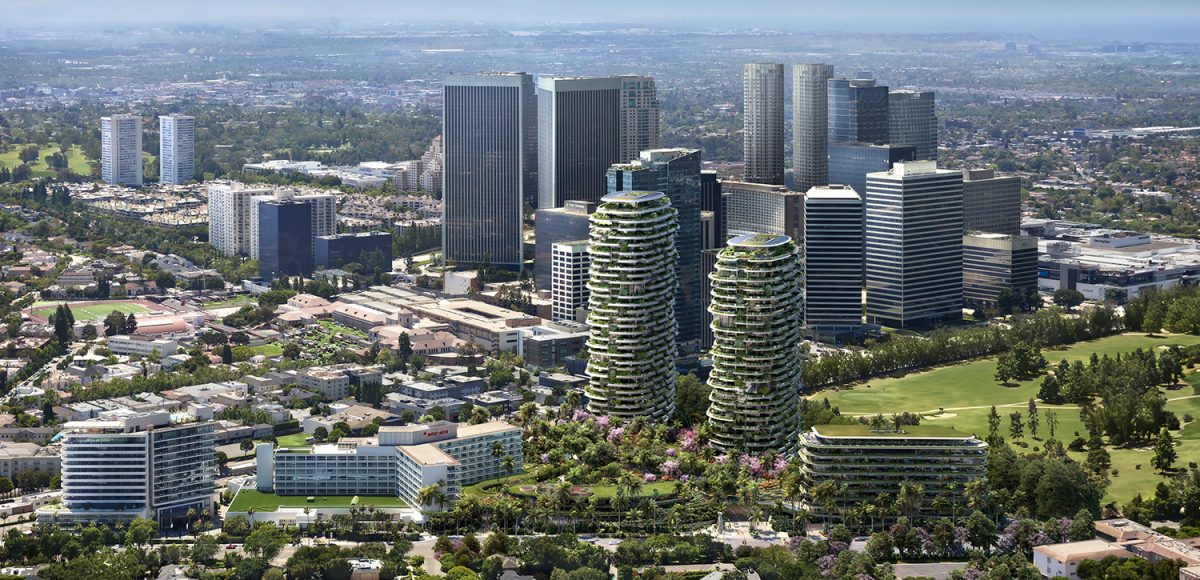Update: The Beverly Hills City Council sat for another marathon meeting about the One Beverly Hills project on May 27. The meeting picked up with an apology from Oasis West Realty CEO Beny Alagem, one of the project’s developers, who accepted responsibility for a letter sent by his attorney that pressured two residents to withdraw a public comment critical of him. The move came to light through Planning Commission Chair Peter Ostroff, who detailed the communication in a comment to the City Council.
The Council then turned to the project’s draft development agreement.
A development agreement functions as a contract between the city and the developer–in this case, Oasis West Realty and Cain International. The agreement assures the developer that the city will not change pertinent regulations during the term of the agreement and will grant certain entitlements that would otherwise conflict with the city’s codes (excessive height, for instance). In return, the city can extract certain demands from the developer as concessions.
The marquee item of the draft development agreement, negotiated by an ad hoc team of city staff, council members, and attorneys, is a $100 million public benefit fee. The unprecedented sum would absolve the development from the responsibility of providing affordable housing, as is required by the city’s Interim Inclusionary Housing Ordinance.
As stated in the draft agreement, “Developer’s Public Benefit Contribution under this Agreement fully satisfies any and all affordable housing fees, or exactions, that are applicable to the Project during the Term.”
The project would also apply a 5% municipal surcharge (essentially a higher Transient Occupancy Tax) to the new Wilshire Building luxury hotel rooms and, in 2030, to the Beverly Hilton starting. Along with that, the project would pay EMS fees to the city, which help the city recoup the revenue lost by allowing residential developments on commercial sites. In the development agreement, the city would receive 2% on first time sales and then 3% on subsequent sales. These would generate revenues for Beverly Hills “in perpetuity” after their implementation, according to Director of Community Development Ryan Gohlich.
City staff who helped negotiate the agreement, along with City Council liaisons Vice Mayor Lili Bosse and Councilmember Lester Friedman, characterized the agreement as historic in the benefits afforded to the city.
Bob Baradaran, an attorney who served as special counsel to the city for the project, described the package of public benefits as “the most lucrative and richest direct public benefit package in favor of any city in the state of California and probably the country.”
But Councilmember John Mirisch raised concerns about the arrangement. Despite the nine-figure public benefit fee, the EMS fees, and the municipal surcharge, Mirisch argued that the development would not be paying its fair share to the city, especially in terms of affordable housing. He pointed to higher EMS fees in comparable cities like London, Paris, New York, and San Francisco ranging from 5.95% to 15% and suggested that the project could shoulder higher fees for the purpose of affordable housing.
Mayor Robert Wunderlich revealed a late-breaking change to the project’s southern access. In an earlier meeting, the Mayor had expressed concern that the design forced anyone coming from Santa Monica Boulevard to enter the gardens through a courtyard elevator located inside the property, which Wunderlich suggested might not be “particularly welcoming.” But on Thursday, Wunderlich announced a pending change that would allow the public to enter from Santa Monica Boulevard via an elevator and ramp immediately accessible to pedestrians.
The Council was unable to complete the approval process at the May 27 meeting and agreed to meet again on June 1 at 2:30 p.m.
The Beverly Hills City Council has moved forward with public hearings on the historic proposed One Beverly Hills project, a luxury hotel and condominium development that would reshape the city’s western Wilshire Boulevard and Santa Monica Boulevard gateways. In extensive questioning, the Council asked the development team about accessibility to the project’s vaunted public gardens, management of the gardens, and concerns over a timeshare-style fractional ownership offering. The Council also discussed a controversial move by lawyers for the project’s developer to pressure a local couple into withdrawing a public comment in advance of the meeting.
If approved, One Beverly Hills would be one of the largest developments in Beverly Hills’ history.
“When opportunity is presented, you have to seize it. You have to know when the moment is here,” said Oasis West Realty CEO Beny Alagem, who is developing the project alongside Cain International. “We finally have the opportunity to do something remarkable, to bring a new level of architecture to our great city, to build exquisite gateways on both Wilshire in Santa Monica that announce the vibrancy and excellence of the city of Beverly Hills, to plant magnificent botanical gardens, to move the Beverly Hilton into the future, to ensure it remains the center of our community life, and to infuse a new level of energy and excitement in Beverly Hills.”
The design of the seven major buildings and the project’s extensive 8-acre garden received universal praise from the Council. Mayor Robert Wunderlich, however, flagged concerns over the accessibility of the 4.5-acre public garden from Santa Monica Boulevard. As the designs stand now, people coming to the gardens by way of Santa Monica would have to either travel through the development, walk through Merv Griffin Way, or walk around to Wilshire Boulevard.
“Would it be possible to have an attractive outdoor escalator [or] an attractive outdoor elevator that might be more immediately apparent to someone showing up on foot?” Wunderlich queried.
One Beverly Hills President Ted Kahan responded that the current design provides ample signage directing visitors taking Santa Monica to the gardens through a courtyard elevator.
Wunderlich also criticized the project for what he viewed as a “car-centric” approach. Kahan was unequivocal in his response: “There is no project in Beverly Hills that’s given more attention to multimodality than this project. Zero, ever.”
The Council also puzzled over a fractional ownership program proposed by the development called the Private Residence Club, which would make 37 fully furnished residential units available to owners for 30-day increments. According to the applicant, interested parties could purchase one-twelfth of a unit, with the option to buy more time if desired. As became clear through the council members’ questions, owners would not own a specific unit, nor would they have the option to decorate or personalize the unit. Rather, they would request specific dates to stay in whichever similar unit were available.
Councilmember Lester Friedman raised some concerns with the program, “which is a new concept in the city of Beverly Hills.” He asked how it differed from a timeshare.
“This is not a resort timeshare product,” Kahan said, pointing out that the value of the asset could appreciate and would require payment of property taxes. “This is an ownership product.”
While Kahan assured Friedman that the Private Residence Club would not participate in “the large national exchange programs” that allows owners in one area to swap units with owners in another, he later clarified that the program would allow exchanges “on a very limited basis.”
The applicant advocated that such arrangements generate more revenue for the city and local businesses.
As 4.5 acres of the project would function as a public park, the Council expressed interest in how the public’s stake in the park would be preserved and how the city could exert oversight. The current plans indicate that the gardens would be managed by a non-profit conservancy. Celebrated local landscape architect Mark Rios, who designed the gardens, likened the arrangement to Central Park in New York City and Millennium Park in Chicago (though both parks are owned by their respective cities).
Gold said that he had seen nonprofits deviate from their mission in the past. “I would ask that as a condition of it, that the city has some significant ability to, for lack of a better word, control what this conservancy does,” he said.
George Mihlstein, an attorney representing One Beverly Hills, offered to “work with staff, perhaps on the concept that each year the 501(c)3 will present a work plan and budget for the year and subject to review by the city and comment by the city.”
The One Beverly Hills team seemed to reverse a previous commitment that “the Botanical Gardens will never be closed for private events at the hotel,” as Kahan said at the April 8 Planning Commission hearing. “Actually, I think we agreed on a condition the other day with staff that would allow the conservancy to have…six events per year,” Kahan said in response to a question from Bosse.
The Public Comment
When members of the public tuned into the May 25 City Council Special Meeting on the proposed development, they heard comments from dozens of residents–over one hour in which residents praised the project as an environmentally sustainable masterpiece, condemned the project for its height and scale, and questioned the timing of the hearing during a pandemic.
In a move that drew reproach from certain members of the City Council, lawyers representing Waldorf Astoria Beverly Hills and One Beverly Hills developer Beny Alagem pressured longtime residents Andrea and Rick Grossman to retract a comment they submitted to the Council, alleging that it contained defamatory statements.
The issue came to light in a lengthy letter submitted to the City Council by Planning Commission Chair Peter Ostroff, who wrote to the Council in his personal capacity.
“This conduct is troublesome because it is apparently intended to inhibit by intimidation public participation regarding the project,” Ostroff wrote.
Ironically, the Grossmans’ comment nonetheless wound up in the public record through Ostroff’s letter, which reprised the comment in full. The comment referenced a Wall Street Journal article about a lawsuit by the Peninsula Beverly Hills hotel alleging, among other things, that a former Peninsula employee gave proprietary client information to the Waldorf Astoria Beverly Hills.
On May 23–two days after emailing their comment to the members of the Council–the Grossmans received an email requesting the couple to “immediately inform” the Mayor and City Council that they retract the statement and their request to have it read into the record. The letter accused them of engaging “in defamation that appears specifically designed to cause significant harm to Mr. Alagem personally and to the proposed development of the multi-billion One Beverly Hills project in Beverly Hills.”
Councilmember John Mirisch viewed the maneuver as a subversion of the democratic process. He called to investigate the matter and look into how the city could stand behind residents in similar situations.
City Attorney Laurence Wiener stated the law clearly protected the Grossmans in this case. “Anyone can be sued for anything,” Weiner said, but California law protects people from claims of defamation by legislative privilege, “which is the ability to address whatever matter is before the City Council on official business.”
Other council members voiced concern of their own over the actions, with Councilmember Lester Friedman, himself an attorney, saying this might be a case of an “overzealous” attorney. Or, as Councilmember Julian Gold, M.D., put it, “lawyers gone wild.”
Vice Mayor Lili Bosse echoed calls to look into how the city could protect residents in these cases, though she repeatedly stressed that “we obviously don’t know the full story.”
Wunderlich described the letter as “heavy handed and could serve to stifle public comment” given the power and resource disparity between the multi-billion-dollar project and a resident.
At the end of the night’s questions, Mirisch pressed Kahan on whether the development’s lawyers would cease sending similar letters to residents in response to comments in the future. After a tense back and forth,Kahan gave a single word answer: “Yes.”
By press time, the City Council had convened for a May 27 meeting in which they are scheduled to present their comments about the project.







